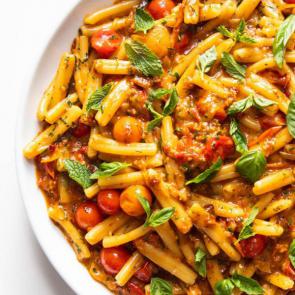پاستا یا خمیراک چیست؟ | معرفی انواع معروف پاستا | قیمت پاستا
 پاستا یا خمیراک (به ایتالیایی: Pasta) به معنی خمیر، یک اصطلاح عمومی برای گونههای مختلف ایتالیایی رشته فرنگی (نودل)، درست شده از خمیر آرد، آب یا تخم مرغ است. پاستا حدوداً به ۳۵۰ شکل مختلف موجود است.
پاستا یا خمیراک (به ایتالیایی: Pasta) به معنی خمیر، یک اصطلاح عمومی برای گونههای مختلف ایتالیایی رشته فرنگی (نودل)، درست شده از خمیر آرد، آب یا تخم مرغ است. پاستا حدوداً به ۳۵۰ شکل مختلف موجود است.چند شکل معروف پاستا اسپاگتی، ماکارونی، فوسیلی و لازانیا (به صورت ورقهای) هستند.در ایران واژه ماکارونی به صورت گسترده برای اسپاگتی، لازانیا و ... به کار میرود.

عکس پاستا | Pasta With Burst Cherry Tomatoes and XO Sauce
برای بزرگنمایی و دانلود تصویر کلیک کنید.
نام دیگر : ماکارونی
کشور : ایتالیا
مواد اصلی موردنیاز : خمیر آرد، آب یا تخم مرغ و سس
انواع : اسپاگتی (استوانهای باریک توپر)، ماکارونی (استوانهای تو خالی یا لولهای)، فوسیلی و لازانیا (به صورت ورقهای) و حدوداً به ۳۵۰ شکل دیگر
نحوه ارائه : گرم
کشور : ایتالیا
مواد اصلی موردنیاز : خمیر آرد، آب یا تخم مرغ و سس
انواع : اسپاگتی (استوانهای باریک توپر)، ماکارونی (استوانهای تو خالی یا لولهای)، فوسیلی و لازانیا (به صورت ورقهای) و حدوداً به ۳۵۰ شکل دیگر
نحوه ارائه : گرم
ماکارونی، پاستا و رشته (لیست جدید)
موارد بیشتر...
Pasta (US: /ˈpɑːstə/, UK: /ˈpæstə/) is an Italian type of food typically made from an unleavened dough of wheat flour mixed with water or eggs, and formed into sheets or other shapes, then cooked by boiling or baking. Rice flour, or legumes such as beans or lentils, are sometimes used in place of wheat flour to yield a different taste and texture, or as a gluten-free alternative. Pasta is a staple food of Italian cuisine.
Pastas are divided into two broad categories: dried (pasta secca) and fresh (pasta fresca). Most dried pasta is produced commercially via an extrusion process, although it can be produced at home. Fresh pasta is traditionally produced by hand, sometimes with the aid of simple machines. Fresh pastas available in grocery stores are produced commercially by large-scale machines.
Both dried and fresh pastas come in a number of shapes and varieties, with 310 specific forms known by over 1300 documented names. In Italy, the names of specific pasta shapes or types often vary by locale. For example, the pasta form cavatelli is known by 28 different names depending upon the town and region. Common forms of pasta include long and short shapes, tubes, flat shapes or sheets, miniature shapes for soup, those meant to be filled or stuffed, and specialty or decorative shapes.
As a category in Italian cuisine, both fresh and dried pastas are classically used in one of three kinds of prepared dishes: as pasta asciutta (or pastasciutta), cooked pasta is plated and served with a complementary side sauce or condiment; a second classification of pasta dishes is pasta in brodo, in which the pasta is part of a soup-type dish. A third category is pasta al forno, in which the pasta is incorporated into a dish that is subsequently baked in the oven. Pasta dishes are generally simple, but individual dishes vary in preparation. Some pasta dishes are served as a small first course or for light lunches, such as pasta salads. Other dishes may be portioned larger and used for dinner. Pasta sauces similarly may vary in taste, color and texture.
In terms of nutrition, cooked plain pasta is 31% carbohydrates (mostly starch), 6% protein, and low in fat, with moderate amounts of manganese, but pasta generally has low micronutrient content. Pasta may be enriched or fortified, or made from whole grains.
History
In the 1st century AD writings of Horace, lagana (singular: laganum) were fine sheets of fried dough and were an everyday foodstuff. Writing in the 2nd century Athenaeus of Naucratis provides a recipe for lagana which he attributes to the 1st century Chrysippus of Tyana: sheets of dough made of wheat flour and the juice of crushed lettuce, then flavoured with spices and deep-fried in oil. An early 5th century cookbook describes a dish called lagana that consisted of layers of dough with meat stuffing, an ancestor of modern-day lasagna. However, the method of cooking these sheets of dough does not correspond to our modern definition of either a fresh or dry pasta product, which only had similar basic ingredients and perhaps the shape. The first concrete information concerning pasta products in Italy dates from the 13th or 14th century.
Historians have noted several lexical milestones relevant to pasta, none of which changes these basic characteristics. For example, the works of the 2nd century AD Greek physician Galen mention itrion, homogeneous compounds made of flour and water. The Jerusalem Talmud records that itrium, a kind of boiled dough, was common in Palestine from the 3rd to 5th centuries AD. A dictionary compiled by the 9th century Arab physician and lexicographer Isho bar Ali defines itriyya, the Arabic cognate, as string-like shapes made of semolina and dried before cooking.
Pastas are divided into two broad categories: dried (pasta secca) and fresh (pasta fresca). Most dried pasta is produced commercially via an extrusion process, although it can be produced at home. Fresh pasta is traditionally produced by hand, sometimes with the aid of simple machines. Fresh pastas available in grocery stores are produced commercially by large-scale machines.
Both dried and fresh pastas come in a number of shapes and varieties, with 310 specific forms known by over 1300 documented names. In Italy, the names of specific pasta shapes or types often vary by locale. For example, the pasta form cavatelli is known by 28 different names depending upon the town and region. Common forms of pasta include long and short shapes, tubes, flat shapes or sheets, miniature shapes for soup, those meant to be filled or stuffed, and specialty or decorative shapes.
As a category in Italian cuisine, both fresh and dried pastas are classically used in one of three kinds of prepared dishes: as pasta asciutta (or pastasciutta), cooked pasta is plated and served with a complementary side sauce or condiment; a second classification of pasta dishes is pasta in brodo, in which the pasta is part of a soup-type dish. A third category is pasta al forno, in which the pasta is incorporated into a dish that is subsequently baked in the oven. Pasta dishes are generally simple, but individual dishes vary in preparation. Some pasta dishes are served as a small first course or for light lunches, such as pasta salads. Other dishes may be portioned larger and used for dinner. Pasta sauces similarly may vary in taste, color and texture.
In terms of nutrition, cooked plain pasta is 31% carbohydrates (mostly starch), 6% protein, and low in fat, with moderate amounts of manganese, but pasta generally has low micronutrient content. Pasta may be enriched or fortified, or made from whole grains.
History
In the 1st century AD writings of Horace, lagana (singular: laganum) were fine sheets of fried dough and were an everyday foodstuff. Writing in the 2nd century Athenaeus of Naucratis provides a recipe for lagana which he attributes to the 1st century Chrysippus of Tyana: sheets of dough made of wheat flour and the juice of crushed lettuce, then flavoured with spices and deep-fried in oil. An early 5th century cookbook describes a dish called lagana that consisted of layers of dough with meat stuffing, an ancestor of modern-day lasagna. However, the method of cooking these sheets of dough does not correspond to our modern definition of either a fresh or dry pasta product, which only had similar basic ingredients and perhaps the shape. The first concrete information concerning pasta products in Italy dates from the 13th or 14th century.
Historians have noted several lexical milestones relevant to pasta, none of which changes these basic characteristics. For example, the works of the 2nd century AD Greek physician Galen mention itrion, homogeneous compounds made of flour and water. The Jerusalem Talmud records that itrium, a kind of boiled dough, was common in Palestine from the 3rd to 5th centuries AD. A dictionary compiled by the 9th century Arab physician and lexicographer Isho bar Ali defines itriyya, the Arabic cognate, as string-like shapes made of semolina and dried before cooking.


